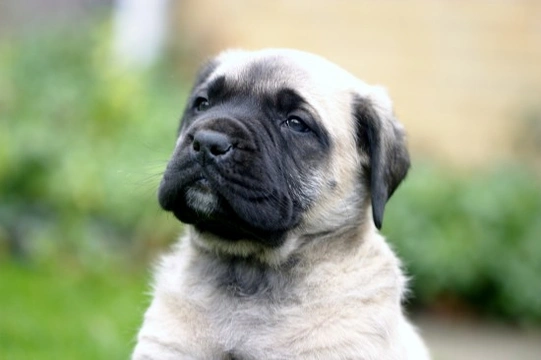
Mastiff dog hereditary health and health testing
The mastiff is a very large dog breed that is both tall and heavy, and naturally, needs a large home and garden in order to be able to move around comfortably! The usage of the term “mastiff” itself can be somewhat confusing, as the term is widely used to refer to a range of dog breeds that have the word mastiff within their breed names, as well as referring to the generic mastiff dog breed itself.
The term mastiff is also often used interchangeably with the term “Molosser,” and so any dog breed that falls within the Molosser type may also be considered to be a mastiff as well!
The mastiff is one of the largest of all breeds in terms of their combined height and weight, and dogs of the breed can stand up to 30” tall at the withers, and weigh up to 110kg. Males of the breed tend to be larger than females, but the females of the breed are certainly not petite themselves!
The mastiff has a huge head and skull, large, heavy body and very square build, with a deep and wide chest. Mastiffs generally have short, close-lying coats, which are generally brindle or fawn, with black markings on the face.
Mastiffs are slow moving, quiet dogs that are very protective of their families, and form strong bonds with their owners. However, due to their sheer size and powerful build, they require a confident and experienced owner to manage them, and are not considered to be a good choice of pet for the first time dog owner.
If you are wondering if the Mastiff is a good choice of dog for you, it is important to find out as much about the breed as possible, including their general health and wellness. In this article, we will look into these factors in more detail.
Genetic diversity within the breed
The coefficient of inbreeding statistic for the breed is 13.3%, which is rather high and indicates that the mastiff breed is subjected to a reasonably high degree of inbreeding. The ideal figure for pedigree dog breeds is 6.25% or lower, and mastiff breeders should reduce the figure within their own breed lines where possible.
Conformation
The sheer size and weight of the mastiff dog means that the legs and joints of the breed are placed under a reasonable amount of pressure, and care should be taken particularly with young dogs to ensure that they do not overexert their still-developing bones and joints.
The skin folds of the face need regular cleaning and drying in order to avoid the build-up of dirt and debris, which can lead to infections.
The deep chest of the mastiff places them at risk of bloat or gastric torsion, a dangerous condition in which the stomach fills with gas and can potentially flip over on itself.
Health testing
In order to ensure that the risk of hereditary health problems being passed on to puppies of the breed is kept to a minimum, the British Veterinary Association and The Kennel Club recommend quite a wide range of pre-breeding health tests for the mastiff dog. Current health schemes and general recommendations for the breed include:
- Hip score testing, with the mean figure across the breed being 18.5, which is quite poor. Potential breeding stock should receive a hip score below this figure to be considered viable.
- Elbow dysplasia, with the idea score being zero.
- DNA testing for progressive retinal atrophy of the eyes.
- DNA testing for multi-focal retinopathy.
- Bitches under 20 months old or over 6 years old should not be used for breeding.
The mastiff breed is classed as a high-profile breed by The Kennel Club, meaning that the breed is closely monitored due to the range of hereditary health problems that can affect the breed.
Other health issues
As well as the conditions mentioned above, the mastiff breed as a whole may also suffer from a fairly wide range of other health problems, but for which no current testing schemes are in place. These problems include:
- Osteosarcoma, and lymphoma, two different types of cancer.
- Ectropion or entropion of the eyelids, which causes the eyelids to turn either outwards or inwards respectively.
- Cystinuria, which leads to the development of kidney stones and bladder stones.
- Vaginal prolapse in young bitches of the breed.
- Atopy, a skin allergy to certain protein particles, including pollen.
- Various types of heart disease, including pulmonic stenosis, and mitral dysplasia.
- Canine acne, generally affecting the muzzle area.
- Cruciate ligament rupture, which affects the hind legs.
- Panosteitis, an inflammatory condition of the bones.
- Osteochondrosis of the shoulders and knees.
- Cataracts of the eyes, particularly in maturity.
- Cherry eye.
- Persistent papillary membranes of the eye, which presents as strands of tissue across the eyeballs, and can impair vision.



